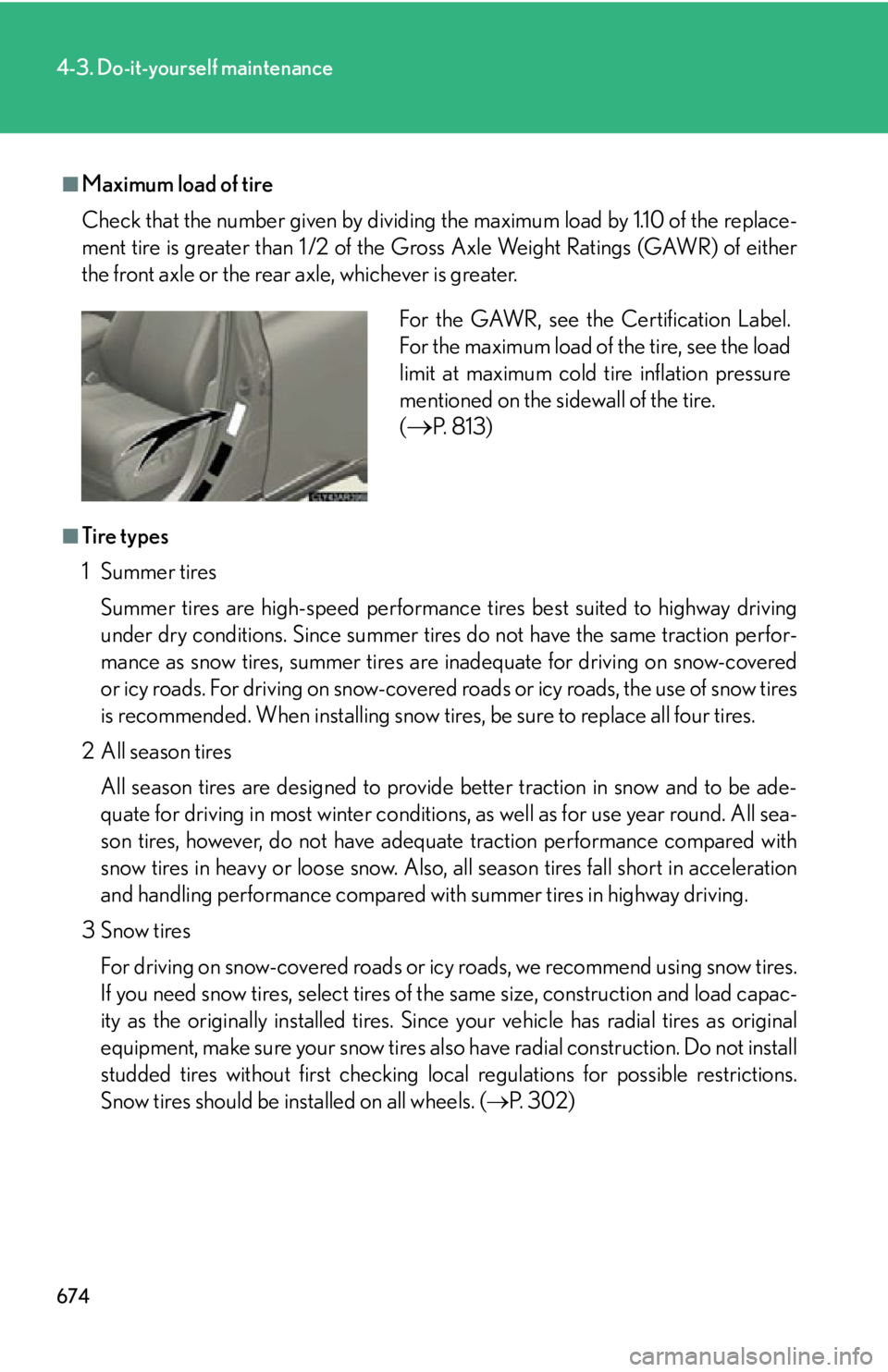Page 320 of 878

3202-5. Driving information
■
Break-in schedule
If your vehicle is new or equipped with any new power train components (such as
an engine, transmission, differential or wheel bearing), Lexus recommends that you
do not tow a trailer until the vehicle has been driven for over 500 miles (800 km).
After the vehicle has been driven for over 500 miles (800 km), you can start tow-
ing. However, for the next 500 miles (800 km), drive the vehicle at a speed of less
than 50 mph (80 km/h) when towing a trailer, and avoid full throttle acceleration.■
Maintenance ●
If you tow a trailer, your vehicle will require more frequent maintenance due to
the additional load. (See “Warranty and Services Guide”, “Owner's Manual
Supplement” or “Scheduled Maintenance”.)●
Retighten the fixing bolts of the towing ball and bracket after approximately
600 miles (1000 km) of trailer towing.■
If trailer sway occurs
One or more factors (crosswinds, passing vehicles, rough roads, etc.) can adversely
affect handling of your vehicle and trailer, causing instability. ●
If trailer swaying occurs:
• Firmly grip the steering wheel. Steer straight ahead.
Do not try to control trailer sway ing by turning the steering wheel.
• Begin releasing the accelerator peda l immediately but very gradually to
reduce speed.
Do not increase speed. Do not apply vehicle brakes.
If you make no extreme correction with the steering or brakes, your vehicle and
trailer should stabilize. ●
After the trailer swaying has stopped:
• Stop in a safe place. Get all occupants out of the vehicle.
• Check the tires of the vehicle and the trailer.
• Check the load in the trailer.
Make sure the load has not shifted.
Make sure the tongue weight is appropriate, if possible.
• Check the load in the vehicle.
Make sure the vehicle is not ov erloaded after occupants get in.
If you cannot find any problems, the speed at which trailer swaying occurred is
beyond the limit of your particular vehicle-trailer combination.
Drive at a lower speed to prevent instability. Remember that swaying of the towing
vehicle-trailer increases as speed increases.
Page 633 of 878

Maintenance and care
4
6334-1. Maintenance and care
Cleaning and protecting
the vehicle exterior............. 634
Cleaning and protecting
the vehicle interior .............. 637
4-2. Maintenance
Maintenance
requirements ........................ 640
General maintenance .......... 643
Emission inspection and
maintenance (I/M)
programs................................ 647 4-3. Do-it-yourself
maintenance
Do-it-yourself service
precautions ........................... 648
Hood ........................................... 651
Positioning a floor jack ......... 652
Engine compartment ........... 654
12-volt battery ........................ 664
Tires............................................. 670
Tire inflation pressure............ 679
Wheels ...................................... 683
Air conditioning filter ........... 685
Electronic key battery.......... 687
Checking and replacing
fuses ........................................ 689
Headlight aim ......................... 705
Light bulbs ................................ 708
Page 646 of 878
6464-2. Maintenance
Vehicle exterior Items Check points
Doors • Do the doors operate smoothly?
Engine hood • Does the engine hood lock system
work properly?
Fluid leaks • There should not be any signs of
fluid leakage after the vehicle has
been parked.
Ti r e s • Is the tire inflation pressure cor-
rect?
• The tires should not be damaged or
excessively worn.
• Have the tires been rotated
according to the maintenance
schedule?
• The wheel nuts should not be loose.
Windshield wipers • The wiper blades should not show
any signs of cracking, splitting,
wear, contamination or deforma-
tion.
• The wiper blades should clear the
windshield without streaking or
skipping.
CAUTION
■
If the hybrid system is operating
Turn the hybrid system off and ensure that there is adequate ventilation before per-
forming maintenance checks.
Page 670 of 878
6704-3. Do-it-yourself maintenance
Tires Replace or rotate tires in accordance with maintenance schedules and
treadwear.
■ Checking tires
New tread
Treadwear indicator
Worn tread The location of treadwear indi-
cators is shown by the “TWI” or
“ ” marks, etc., molded on the
sidewall of each tire.
Check spare tire condition and
pressure if not rotated.
■ Tire rotation
Vehicles with a compact spare tire
Rotate the tires in the order
shown. To equalize tire wear and extend
tire life, Lexus recommends that
tire rotation is carried out at the
same interval as tire inspection.
Vehicles with a full-size spare tire
Rotate the tires in the order
shown.
To equalize tire wear and extend
tire life, Lexus recommends that
tire rotation is carried out at the
same interval as tire inspection.Front
Front
Page 671 of 878

6714-3. Do-it-yourself maintenance
4
Maintenance and care
Installing tire pressure warning valves and transmitters
When replacing tires or wheels, tire pressure warning valves and trans-
mitters must also be installed.
When new tire pressure warning va lves and transmitters are installed,
new tire pressure warning valve and transmitter ID codes must be regis-
tered in the tire pressure warning co mputer and the tire pressure warning
system must be initialized. Have tire pressure warning valve and transmit-
ter ID codes registered by your Lexus dealer. ( P. 6 7 3 )
Initializing the tire pressure warning system
■ The tire pressure warning system must be initialized in the following
circumstances:
● When rotating the tires
● When the tire inflation pressure is changed such as when changing
travelling speed or load weight
● When changing the tire size
When the tire pressure warning sy stem is initialized, the current tire
inflation pressure is set as the benchmark pressure.■ The tire pressure warning system
Your Lexus is equipped with a tire pressure warning system that uses
tire pressure warning valves and tr ansmitters to detec t low tire infla-
tion pressure before serious problems arise. ( P. 7 3 6 )
Page 673 of 878

6734-3. Do-it-yourself maintenance
4
Maintenance and care Registering ID codes
The tire pressure warning valve and transmitter is equipped with a unique
ID code. When replacing a tire pressure warning valve and transmitter, it
is necessary to register the ID code. Ha ve the ID code registered by your
Lexus dealer. ■
When to replace your vehicle’s tires
Tires should be replaced if: ●
You have tire damage such as cuts, splits, cracks deep enough to expose the
fabric, and bulges indicating internal damage.●
A tire goes flat repeatedly or cannot be properly repaired due to the size or
location of a cut or other damage.
If you are not sure, consult with your Lexus dealer.■
Replacing tires and wheels
If the ID code of the tire pressure warn ing valve and transmitter is not registered,
the tire pressure warning system will not work properly. After driving for about 20
minutes, the tire pressure warning light blin ks for 1 minute and stays on to indicate a
system malfunction.■
Tire life
Any tire over 6 years old must be checked by a qualified technician even if it has sel-
dom or never been used or damage is not obvious.■
If the tread on snow tires wears down below 0.16 in. (4 mm)
The effectiveness of the tires as snow tires is lost.■
Routine tire inflation pressure checks
The tire pressure warning system does not replace routine tire inflation pressure
checks. Make sure to check tire inflation pressure as part of your routine of daily
vehicle checks.
Page 674 of 878

6744-3. Do-it-yourself maintenance
■
Maximum load of tire
Check that the number given by dividing the maximum load by 1.10 of the replace-
ment tire is greater than 1 /2 of the Gr oss Axle Weight Ratings (GAWR) of either
the front axle or the rear axle, whichever is greater.
■
Tire types
1 Summer tires
Summer tires are high-speed performance tires best suited to highway driving
under dry conditions. Since summer tires do not have the same traction perfor-
mance as snow tires, summer tires are inadequate for driving on snow-covered
or icy roads. For driving on snow-covered roads or icy roads, the use of snow tires
is recommended. When installing snow tires, be sure to replace all four tires.
2 All season tires
All season tires are designed to provide better traction in snow and to be ade-
quate for driving in most winter conditions , as well as for use year round. All sea-
son tires, however, do not have adequa te traction performance compared with
snow tires in heavy or loos e snow. Also, all season tires fall short in acceleration
and handling performance compared with summer tires in highway driving.
3Snow tires
For driving on snow-covered roads or ic y roads, we recommend using snow tires.
If you need snow tires, select tires of the same size, construction and load capac-
ity as the originally installed tires. Since your vehicle has radial tires as original
equipment, make sure your snow tires also have radial construction. Do not install
studded tires without first checking local regulations for possible restrictions.
Snow tires should be installed on all wheels. ( P. 3 0 2 )For the GAWR, see the Certification Label.
For the maximum load of the tire, see the load
limit at maximum cold tire inflation pressure
mentioned on the sidewall of the tire.
(
P. 8 1 3 )
Page 675 of 878

6754-3. Do-it-yourself maintenance
4
Maintenance and care ■
The initialization operation ●
Make sure to carry out initialization af ter adjusting the tire inflation pressure.
Also, make sure the tires are cold before carrying out initialization or tire infla-
tion pressure adjustment.●
If you have accidentally turned the “POWER ” switch off during initialization, it is
not necessary to press the reset switch again as initialization will restart auto-
matically when the “POWER” switch has been turned to ON mode for the next
time.●
If you accidentally press the reset switch when initialization is not necessary,
adjust the tire inflation pressure to th e specified level when the tires are cold,
and conduct initialization again.■
When the initialization of the tire pressure warning system has failed
Initialization can be completed in a few minutes. However, in the following cases,
the settings have not been recorded and the system will not operate properly. If
repeated attempts to record tire inflation pressure settings are unsuccessful, have
the vehicle inspected by your Lexus dealer. ●
When operating the tire pressure warnin g reset switch, the tire pressure warn-
ing light does not blink 3 times. ●
After carrying out the initialization proc edure, the tire pressure warning light
blinks for 1 minute then stays on after driving for 20 minutes.